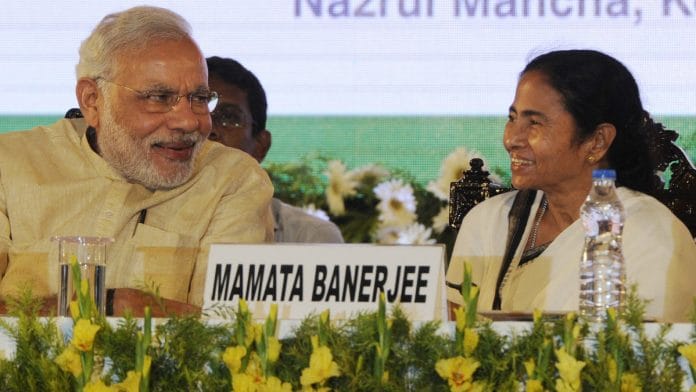On 2 May, when the Communist Party of India (Marxist)’s outgoing MLA-cum-mayor of Siliguri Asok Bhattacharya, one of the party’s last stalwarts in the state, ranked third on his home turf, the largest commercial town in north Bengal that elected him five times, it formally marked a shift in the state’s politics. For the first time in the history of West Bengal, the Left and the Congress will have no representation in the state assembly.
Mamata Banerjee’s Trinamool Congress (TMC) won with nearly a three-fourth majority, while the Bharatiya Janata Party (BJP) emerged as the only opposition party.
The Left and the Congress had been reduced to complete insignificance as Bengal stood polarised between the TMC and BJP, though overwhelmingly in favour of the former. Based on the latest trends while writing this, the TMC won the biggest share of votes (48 per cent) it ever got since its birth in 1998. Going by the number of seats, too, it’s the TMC’s highest tally. The final tally is TMC 213 and BJP 77, as per the ECI website on 3 May.
Nevertheless, Mamata Banerjee, who matured as a politician fighting the Left, now has to face the Right as her opposition. In Syama Prasad Mookerjee’s Bengal, political Hindutva has formally arrived.
Also read: Didi is now the dada of Bengal. This is India’s ‘jhaal muri’ moment
TMC’s new chief rival
The Congress was routed from Murshidabad that has been a bastion of Bengal Congress president Adhir Ranjan Chowdhury, who has also served as the leader of the party in the Lok Sabha until recently. Even in this district, with two-thirds Muslim population, it was the BJP — which failed to make any mark in the 2019 Lok Sabha elections — that has emerged as the TMC’s chief rival.
In another bastion of the Congress, Malda, the party faced a similar rout.
The Left did not have any particular bastion left and managed to get only 4.95 per cent of the polled votes, while the Congress’s vote share stood at 2.94 per cent. In the 2019 Lok Sabha election, the two parties, even though contested separately, had a combined vote share of 12 per cent. The Congress had won two Lok Sabha seats by virtue of leading in nine assembly segments. In all these segments, the Congress stood a distant third this time.
On Sunday, it became evident that the TMC had gained votes from the Left and the Congress in many pockets, while in some other areas, the Left-Congress’ traditional votes went to the BJP.
Now, Mamata Banerjee will have an assembly where there will only be BJP MLAs in the opposition, making about one-fourth of the total members, except for an MLA each from the Gorkha Janmukti Morcha and the Indian Secular Front.
And it appears that she has prepared herself for that. The first thing she did after the TMC victory became certain is visit the Kalighat temple and offer a puja to the goddess.
In 2016, the state had a unique scene of opposition politics, with the Congress and the Left as the major opposition in the assembly, but the BJP as the main opposition on the ground. As a result, the BJP managed to emerge as the TMC’s principal rival in the 2018 panchayat election and cemented this position in the 2019 Lok Sabha election. Now, the BJP is the opposition in the assembly and is expected to be the opposition on the field, too.
This is in sharp contrast to West Bengal’s political history, where the battle was between the Congress and the Left between 1952 and 1998, and between the Left, the Congress and the TMC between 1998 and 2011. The BJP won their first seat in the state on their own, in a 2014 by-election held after the Lok Sabha election.
From one seat in the 2014 by election, the BJP managed to increase its tally in West Bengal’s assembly election to three in 2016. Now, it has achieved a giant leap by winning 77 seats.
Also read: Where is the opposition in Modi’s India? It is here and finally with a face
What went wrong, Right and Left
The BJP on Sunday appeared confused about its future role. State unit president Dilip Ghosh said that the party will need to conduct a thorough assessment of what went wrong — including its policies, strategy and tactics. A senior BJP leader told me, requesting anonymity, that the party needed to assess if a high-pitched Hindutva campaign actually resulted in a consolidation of “secular-liberal Hindu votes” behind the TMC.
It is noteworthy that Mamata Banerjee had toppled the Left Front government in 2011 by arming herself with the very slogans that had brought the Left parties to power in 1977; such as ‘land to the tillers.’ She had portrayed herself as the ‘real Left’ and portrayed the Left Front as forces that had deviated from their ideology. As late as during the 2021 election campaign, TMC minister Bratya Basu, himself a theatre personality who adhered to Leftist ideology, had dubbed Mamata Banerjee as the ‘real Left.’
As it appeared after Sunday’s results, Mamata Banerjee has captured the Leftist space in the state.
Ahead of the elections, the state stood witness to a high-voltage campaign on communal lines with the BJP’s senior leaders accusing the TMC of depriving Bengal’s Hindus for the sake of pleasing Muslims. On the ground, this campaign resonated with a great number of people. As the BJP emerged as her only opponent in the state, Bengal is likely to see another period of bipolar politics after 1997, when Mamata Banerjee will have to take her steps considering how the BJP might respond.
Snigdhendu Bhattacharya is an independent journalist and author of the book, Mission Bengal: A Saffron Experiment. Views are personal.
[Edited by Fiza Ranalvi Jha]






